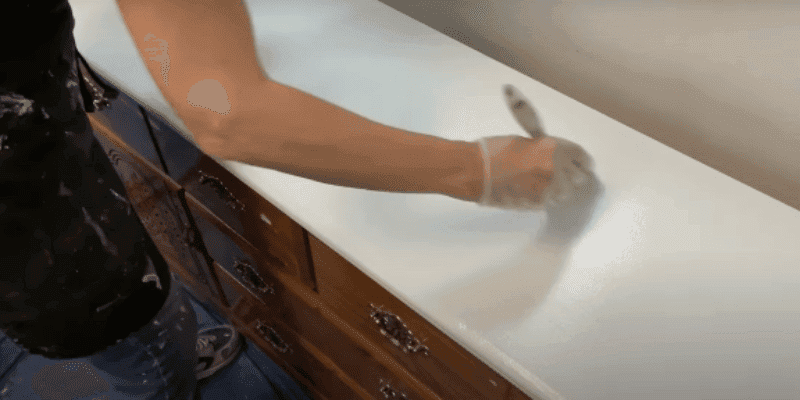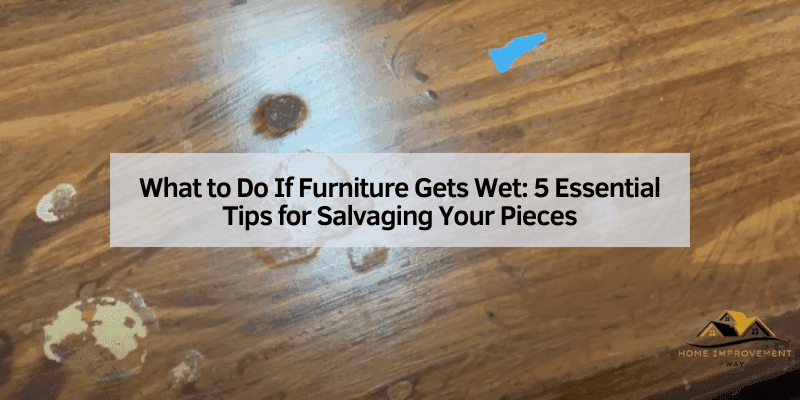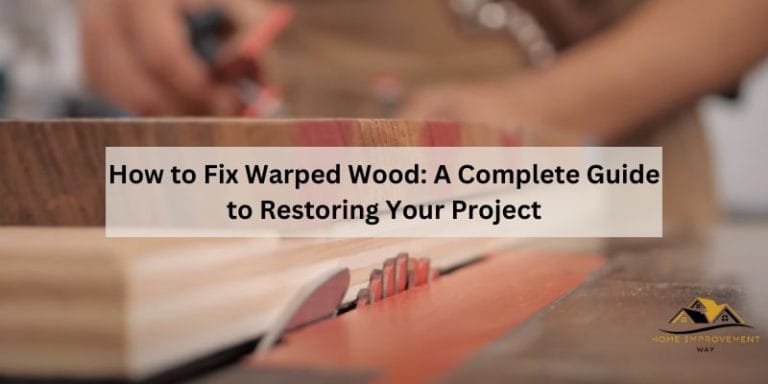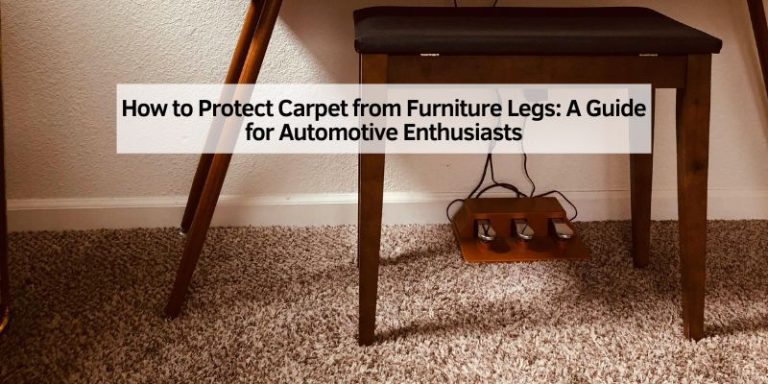What to Do If Furniture Gets Wet: 5 Essential Tips for Salvaging Your Pieces
If furniture gets wet, immediately remove excess moisture and allow it to dry completely. To prevent mold and mildew, clean and disinfect the affected areas, and consider using a dehumidifier to speed up the drying process.
Whether it’s due to a spill, flood, or high humidity, wet furniture requires prompt action to avoid long-term damage. The type of material, extent of saturation, and duration of exposure all play a role in determining the best course of action.
By following these steps, you can effectively address the issue of wet furniture and prevent potential damage. Taking quick and thorough measures will help protect your furniture investment and ensure long-lasting enjoyment of your prized pieces.
Understanding The Impact Of Water Damage
After experiencing water damage, it’s crucial to take immediate action to salvage wet furniture. Start by removing any moisture as soon as possible with towels or a wet/dry vacuum. Then, allow the furniture to air out in a well-ventilated area, and consider using dehumidifiers or fans to expedite the drying process.
This will help prevent mold and mildew growth and prolong the life of your furniture.
Recognizing Different Types Of Water Damage
Water damage can wreak havoc on furniture, so understanding its impact is crucial. When furniture is exposed to water, it can lead to various types of damage, including swelling, warping, discoloration, and mold growth. It’s essential to recognize these different types of water damage to address the issue effectively.
Assessing The Extent Of Damage
Once furniture is affected by water, it’s important to assess the extent of the damage. This involves inspecting the furniture for visible signs of water damage such as stains, discoloration, and warping. Additionally, checking for hidden damage such as mold growth and structural weaknesses is vital to determine the overall condition of the furniture.
When furniture gets wet, it can lead to various types of damage. By recognizing the different types of water damage, we can effectively address the issue and mitigate the impact. Assessing the extent of damage is crucial to determine the overall condition of the furniture and take appropriate action.
Immediate Steps To Salvage Wet Furniture
When furniture gets wet, it’s important to take immediate action to salvage it. The longer the furniture remains wet, the more likely it is to suffer irreversible damage such as warping, molding, or mildewing. By following the immediate steps outlined below, you can increase the chances of salvaging your wet furniture and preventing further damage.
Removing Excess Moisture
Before attempting to dry the furniture, it’s crucial to remove as much excess moisture as possible. Start by blotting the surface with a clean, dry cloth or sponge to absorb the moisture. Avoid rubbing, as this can push the water further into the furniture’s material and cause more damage.
If the furniture has removable cushions or upholstery, take them off and place them in a well-ventilated area to dry separately. Additionally, if the furniture is made of wood, consider opening any drawers or doors to allow for better air circulation and aid in the drying process.
Properly Drying The Furniture
After removing excess moisture, it’s essential to thoroughly dry the furniture to prevent the growth of mold and mildew. Utilize fans, dehumidifiers, or open windows to promote air circulation around the wet furniture. Directing a fan towards the furniture can help accelerate the drying process. If the weather permits, placing the furniture outdoors in a shaded area can also aid in drying.
For wooden furniture, it’s advisable to avoid direct sunlight, as excessive heat can cause the wood to warp or crack. Instead, aim for a controlled drying environment to prevent further damage. Regularly inspect the furniture for any signs of mold or mildew, and address these issues promptly to prevent them from spreading.

Restoring Damaged Wood Furniture
Wooden furniture can be vulnerable to water damage, leading to issues such as water stains, discoloration, warping, and cracking. When faced with wet or damaged wood furniture, taking prompt and proper action is crucial to mitigate the harm and restore the beauty and integrity of the pieces. Below, we’ll discuss how to address water stains and discoloration as well as how to repair warped or cracked wood to ensure your furniture looks brand new again.
Addressing Water Stains And Discoloration
Absorbing excess moisture should be the priority when dealing with water stains on wood furniture. Begin by patting the affected areas with a soft, dry cloth to remove any surface moisture.
For stubborn water stains, mix baking soda with water to form a paste and gently rub it onto the stained area. Allow it to sit for a few minutes before wiping it off with a clean, damp cloth. This remedy can help lift the stain and restore the wood’s natural color.
Repairing Warped Or Cracked Wood
Warped or cracked wood can be meticulously restored with the right approach. If your furniture has warped, place it in a dry, well-ventilated area to allow the wood to gradually return to its original shape. Avoid exposing it to direct sunlight or heat, as this could cause further damage during the drying process.
When repairing cracked wood, applying wood glue to the affected areas and clamping them together until the adhesive sets can effectively mend the cracks. Once dry, sand down the repaired areas and refinish them to seamlessly blend in with the rest of the piece.
Salvaging Upholstered Furniture
If your upholstered furniture has been exposed to water, acting quickly is crucial to salvage it. Water damage can lead to mold, mildew, and permanent fabric discoloration. Learn the steps to salvage your upholstered furniture and prevent further damage.
Dealing With Mold And Mildew
Mold and mildew can quickly develop on wet upholstery, causing health risks and further damage. Follow these steps to address mold and mildew:
- First, ensure the affected area is completely dry by using fans and dehumidifiers.
- Vacuum the furniture thoroughly to remove any visible mold or mildew.
- For persistent mold and mildew, consider using a mixture of water and mild soap or a specially formulated fabric mold and mildew cleaner.
- Allow the furniture to air dry completely in a well-ventilated area.
Cleaning And Restoring Fabric And Cushions
After addressing mold and mildew, focus on cleaning and restoring the fabric and cushions:
- For light stains, spot clean the affected areas with a mixture of mild detergent and water. Blot the area gently with a clean, absorbent cloth.
- For deeply soaked cushions, consider using a wet vacuum to extract excess moisture.
- If the cushions are machine washable, follow the manufacturer’s instructions for cleaning. If not, contact a professional upholstery cleaner.
- Once the fabric and cushions are clean and dry, consider using a fabric protectant to prevent future water damage.
Preventive Measures And Aftercare
Water damage to furniture is a common concern, especially in homes prone to leaks or flooding. However, taking preventive measures and providing proper aftercare can make a significant difference in preserving the integrity of your furniture. By implementing these strategies, you can effectively protect your furniture from water damage and ensure its longevity.
Tips For Preventing Future Water Damage
To prevent future water damage to your furniture, taking proactive measures is crucial. Here are some tips to safeguard your furniture from potential water exposure:
- Place moisture-absorbing silica gel packets inside cabinets and drawers to prevent moisture buildup.
- Utilize furniture coasters or protective mats to create a barrier between the furniture and damp floors.
- Regularly inspect the plumbing and fixtures in your home to detect and address any leaks promptly.
- Apply waterproof sealants and finishes to wooden furniture to create a protective barrier against moisture.
Maintaining Salvaged Furniture For Longevity
If salvaged furniture has been subjected to water damage, proper aftercare is essential to ensure its longevity. Here’s how you can maintain salvaged furniture:
- Thoroughly dry the furniture by placing it in a well-ventilated area and using fans or dehumidifiers to expedite the drying process.
- Inspect the furniture for any signs of mold or mildew and address these issues immediately with appropriate cleaning solutions.
- For wooden furniture, sand the affected areas and apply wood preservatives to prevent further damage and restore its original luster.
- Regularly monitor the salvaged furniture for any reoccurrence of water damage and take preventive actions as necessary.
Frequently Asked Questions On What To Do If Furniture Gets Wet
What Are The Immediate Steps To Take If Furniture Gets Wet?
Promptly blot excess water and place furniture in a dry, airy space. Use fans or dehumidifiers to speed up drying process. Remove cushions and upholstery, and wipe down the surfaces with a dry cloth.
How Can I Prevent Mold And Mildew From Forming On Wet Furniture?
Ensure the furniture is dried thoroughly. Use a mixture of water and vinegar to wipe down surfaces to prevent mold and mildew growth. In humid climates, utilize a dehumidifier to maintain optimal moisture levels.
Is It Safe To Use Heat Sources To Dry Wet Furniture?
Avoid direct heat, such as hairdryers or heat guns, as it can damage the furniture. Opt for indirect heat sources like fans or dehumidifiers to aid in the drying process and prevent potential damage.
Conclusion
When your furniture gets wet, quick action is key to preventing further damage. By following the right steps, such as drying and cleaning the furniture properly, you can salvage your beloved pieces. Remember to assess for mold and seek professional help if needed.
Taking care of wet furniture promptly can save you time and money in the long run.






